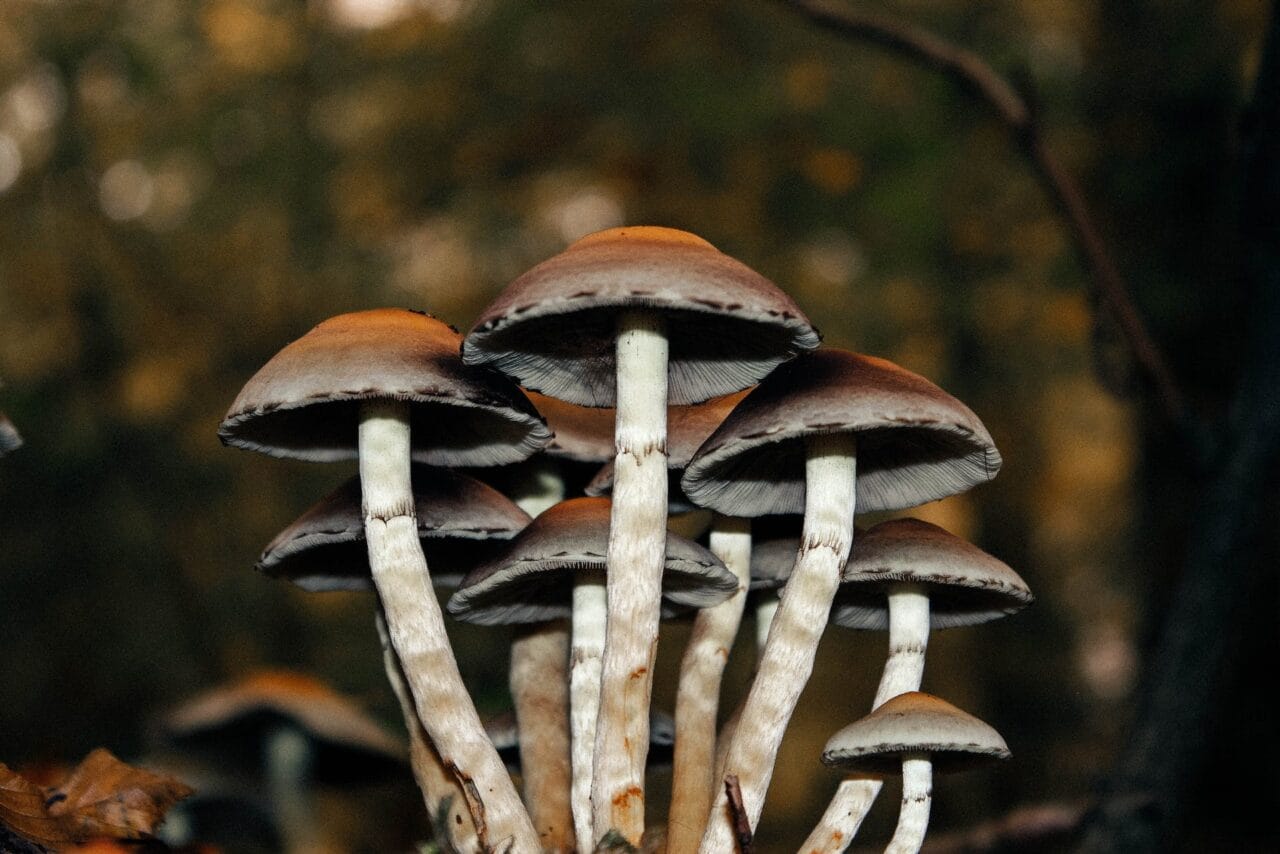Psilocybin, a psychoactive compound present in magic mushrooms, is commonly used recreationally for its euphoria-inducing and hallucinogenic effects.
In addition to its mind-altering abilities, psilocybin’s potential for chronic pain alleviation is also being scientifically explored.
This article showcases a case study that investigates the potential of microdosing mushrooms in providing relief from chronic pain.
Key Takeaways:
- Microdosing mushrooms may provide both immediate and sustained pain relief.
- When compared to traditional pain medications, microdosing psilocybin often has fewer side effects if administered in small quantities.
- Psilocybin interacts with the serotonin 2A (5-HT2A) receptors, potentially alleviating pain among other conditions.

The Study
The research titled “Microdosing Psilocybin for Chronic Pain: A Case Series” was carried out by Dr. Matthew Lyes and his team from the Division of Pain Medicine in the Department of Anesthesiology at the University of California, San Diego. The study was centered on three patients who self-administered minor doses of psilocybin to alleviate their chronic pain symptoms.
Three Patients, One Result – Chronic Pain Reduction
Patient # 1
| AGE/ GENDER: | 37 Male |
| PAIN TYPE: | Neuropathic pain occurring below a spinal cord injury site. |
| PAIN INTENSITY: | Initially 4 to 5/ 10, increasing to 8/ 10 later in the day |
| PSILOCYBIN DOSE: | 250 mg of ground mushroom for less than 6 months |
| RESULT: | Discontinuation of prescribed pain medication, decrease in muscle spasms, and improved bowel movement efficiency. No signs of rebound pain or withdrawal symptoms were observed. |
| The patient reported that unlike his regular medications which only managed to lessen the pain, psilocybin effectively eliminated it, bringing his average pain level down from 5 to 0. | |
Case Study: Second Patient
| AGE/ GENDER: | 69-year-old Female |
| PAIN TYPE: | Complex Regional Pain Syndrome (CRPS) |
| PAIN INTENSITY: | Generally 5 to 7 out of 10, increases with physical activity and during flare-ups |
| PSILOCYBIN DOSAGE: | 500 mg daily consumption for 7 to 10 days with rest periods (2 to 3 days) for a year. Dosage increases to 750 mg to 1 gram during flare-ups |
| EFFECT: | 80% reduction in pain lasts 3-4 hours, slowly returning to initial levels after 12 hours. Complete pain relief (90%-100%) lasts 6-8 hours, returning to initial levels after 18 hours. |
| The patient notes a decrease in appetite without experiencing nausea. Disorientation or difficulty in walking is observed when the dosage is increased (750 to 1000mg). | |
Case Study: Third Patient
| AGE/ GENDER: | 40-year-old Female |
| PAIN TYPE: | Lumbar radiculopathy and neuropathic pain |
| PAIN INTENSITY: | 8 out of 10, spikes to 10 out of 10 during physical activity |
| PSILOCYBIN DOSAGE: | 1000 mg from a mushroom chocolate bar every two months. |
| EFFECT: | Significant pain relief without any psychoactive effects. Increased flexibility and functionality observed. Pain slowly returns to initial levels over 2-4 weeks. Repeated dosing improves pain management. |
| The patient doesn’t report any noticeable physical, cognitive, or behavioural side effects. Her mood remains largely stable. She continues her regular SSRI dosage for depression management throughout the psilocybin treatment period. | |
Exploring Psilocybin for Pain Management
Continuous somatic and visceral pain signals strengthen certain neural pathways due to peripheral and central sensitization, leading to chronic physical and emotional pain. Psychedelics like psilocybin can activate 5-HT2A receptors, potentially resetting the brain areas linked with neuropathic conditions.
One patient reported pain relief lasting for weeks. This suggests that directly stimulating the 5-HT2A receptors can lead to a central regulation of pain perception and
Potential adaptability of synapses.
Possible Side Effects of Psilocybin Vs. Traditional Painkillers
| PSILOCYBIN (Based on Studies) | TRADITIONAL PAINKILLERS |
| Muscle spasms | Nausea |
| Appetite loss | Stomach discomfort |
| Confusion | Headaches |
| Unsteady gait | Addiction risk |
| No change in mood | Drowsiness |
Potential Future Studies on Psilocybin
The researchers, having studied the experiences of three subjects, have identified specific potential benefits that merit further investigation.
- Small doses of psilocybin could provide immediate and possibly lasting relief from neuropathic pain, without resulting in physical tolerance or addiction.
- Research the effects of combining different treatment approaches with psilocybin. For example, patient #3 reported enhanced pain relief when psilocybin was used in conjunction with physical therapy.
- Small psilocybin doses might offer pain relief, even without psychotherapy, as demonstrated in this case study. The scholars propose that incorporating therapeutic supervision could potentially boost or prolong the therapeutic effects.
Study Limitations
Despite the encouraging outcomes in the subjects, it’s crucial to acknowledge the study’s identified limitations.
- The study’s small sample size may not fully represent all neuropathic pain sufferers.
- The study did not include any subjects who had no response to psilocybin.
- There were no pre- and post-treatment evaluations to measure the effects of psilocybin on psychiatric disorders like depression and anxiety.
- Most of the data was self-reported by the subjects.
- The presence of the interviewer and potential bias towards psilocybin might have influenced participants’ responses.
- The study did not examine the impact of the placebo effect.
- The study did not measure the psilocybin content in each mushroom.
Exploring the Effects of Microdosing Mushrooms
In the study under discussion, patients #1 and #2 consumed a microdose of powdered psilocybin derived from dried mushrooms, whereas patient #3 blended it with chocolate. We present a list of products specifically designed for psilocybin microdosing below.
Dried Mushroom Varieties
The research does not mention the specific strain used. However, the following strain is recommended for those new to the practice.
- Golden Teacher: This is one of the most frequently found and widely recognized magic mushroom strains.
- Amazonian Cubensis: This strain is known to be beginner-friendly and may offer cognitive enhancements.
- Cambodian: The Cambodian cubensis strain, when used for microdosing, may improve focus, social awareness, and mood.
Microdose Capsule Options
- Euphoria Psychedelics – Micro Calm Capsules: This concoction combines Ashwagandha, Reishi, CBD, Valerian root, and Psilocybin Mushrooms, all scientifically validated to alleviate anxiety and stress.
- Ground Sounds – Microdose Capsules – Champion Lover: This appealing blend provides three dosage levels: 50mg, 100mg, or 250mg of pure psilocybin combined with reishi, cacao, cordyceps, and maca.
- Kind Stranger – Brighten Capsules 250mg: These capsules incorporate the Golden Teacher strain, known to enhance clarity, boost creativity, and improve focus.
Psilocybin’s Potential in Pain Relief
Although the research on mushrooms’ potential to alleviate pain is still in its infancy, anecdotal reports and preliminary case studies are showing promising signs.
Such instances underscore the necessity for additional examination into the prospective benefits of psilocybin, class=”wp-block-list”>
Before the wide acceptance of psilocybin as a pain relief agent, encouraging results from case studies have provided hope for individuals grappling with chronic pain.
Frequently Asked Questions
What are the effects of microdosing psilocybin?
The primary action of psilocybin is stimulating a serotonin receptor known as “5-HT2A” in the prefrontal cortex, which leads to two main outcomes:
- Generation of “Brain-Derived Neurotrophic Factor” (BDNF)
- Augmented “Glutamate” transmission
Moreover, psychedelics promote links between brain regions that usually do not interact. This unique connectivity arises from the ability of psychedelics to diminish the activity of the “Default Mode Network” (DMN), which is associated with various cognitive functions such as daydreaming, introspection, and reflecting on the past and future.
What is the most notable benefit of microdosing mushrooms?
Microdosing can potentially enhance mood, productivity, creativity, and focus. Its most extensively researched benefit is its effect on mental health.
In November 2022, COMPASS Pathways, a company focusing on mental health, shared the findings of their exhaustive phase 2b trial, a randomized and double-blind study. Their investigation indicated that a single dose of psilocybin resulted in significant reductions in symptoms of depression compared to a placebo. Participants who received a higher dose of 25 milligrams showed a sustained antidepressant response at the twelve-week follow-up.
A study published in the Psychiatry Research Journal suggested that psilocybin is more effective than traditional antidepressant treatments.
How can one determine the appropriate dosage?
Start with a 0.1-gram dose of psilocybin mushrooms on the first day. If the desired effects are not achieved, you can slowly increase your dose by 0.05 grams on subsequent microdosing days until you reach your ideal dosage.
Individuals with a history of psychotropic drug use may need to increase the dosage to 0.5 grams to achieve the desired effects.
What should be done before taking mushrooms?
- Allocate some time to understand the reason behind your decision to microdose on a specific day.
- Take time to self-reflect and connect with your current emotional or mental state. Acknowledge the feelings or mindset you believe will be advantageous for you that day.
- Once your goals are clearly outlined, write them down. Formulating your objectives as affirmations can aid significantly in your continuous growth.
- Direct your focus towards the experience you aim to achieve, rather than what you want to steer clear of.
- Consume the microdose on an empty stomach, preferably an hour before the first meal of your day.
How often should microdoses of mushrooms be consumed?
There are several well-established guidelines suggesting structured microdosing schedules for psychedelics. These guidelines primarily differ in the number of “off” days they include, which are days you abstain from microdosing.
The most commonly suggested guidelines recommend 1-3 rest days between microdoses. This aligns with the body’s natural tolerance mechanisms. The three protocols discussed in this context are the Fadiman Protocol, the Stamets Stack, and intuitive microdosing.




